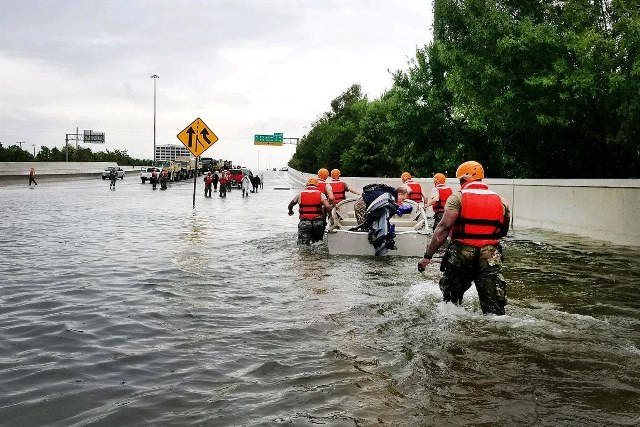
Image source: Texas Army National Guard
Many corporations expressed their sympathy for victims of Hurricane Harvey on Twitter. More importantly, many announced donations of cash and products. AT&T and Verizon, two of the state’s biggest companies, announced they would offer free data to customers in storm-damaged areas.
A few, however, were not so thoughtful or compassionate. Public relations consultant Kara Alaimo took issue with tweets by Chick-fil-A, Burger King and Target. During the height of the storm, Chick-fil-A, with a large presence in the Houston area, promoted its hash brown scrambles. Burger King tweeted that “The secret to happiness is Chicken Fries.” Target, the state’s most popular shopping chain, tweeted: “We’re pawsitively pumped for #NationalDogDay! Spoil your fur baby with our latest & greatest pet products.” All of those tweets could well have been prepared well in advance and published on an automated schedule.
“Those tone-deaf tweets were a big mistake,” Alaimo asserts in a Bloomberg article. “The most appropriate things for companies to do are to express sympathy and, ideally, offer aid to the victims.”
Research shows that Americans strongly believe businesses should practice corporate social responsibility. A 2017 study by Cone Communications found that 70 percent of Americans expect companies to take action on social challenges, even when they’re not related to their core business functions. Eighty-seven percent say that a company’s values are a factor in their purchasing decisions.
How to be Hated
The worst mistake is to try to take advantage of a calamity by selling more products. The tactic will surely draw condemnation. However, promising to donate a portion of sales during a disaster to relief efforts can both enhance the brand’s image and boost sales.
Beware of automatic scheduling. Scheduling tweets in advance, especially over the weekend during off-hours, is a common practice in social media marketing circles. An unexpected natural disaster may strike after a promotional tweet is scheduled. Marketers may forget about the scheduled tweets.
Bury this tactic. Trying to bury negative news during a disaster may ultimately backfire. Some corporations hope their negative news will garner little media coverage during a disaster. Politicians are frequent practitioners of the tactic. The White House issued three controversial announcements just as Harvey was about to smash into Texas – and on a Friday. Observers saw through the attempted timing trick, according to Bloomberg.
Companies often release poor quarterly results on Friday afternoons in an effort to minimize media coverage. It doesn’t work. A 2004 study found more volatility in company stock prices when they delivered bad news on Fridays.
“Instead, corporate communicators should focus on not letting themselves become distracted when it’s appropriate to respond to catastrophes in their communities,” Alaimo concludes.
Other Tips for Tweets during Natural Disasters
Social media marketers frequently oversee company accounts with large numbers of followers, often more than local government agencies. In addition, personal accounts of social media consultants and corporate social media managers often boast sizable numbers of followers. What they share can have a noticeable impact.
Don’t support fake news; Verify before retweeting. Social media hoaxes tend to spread faster during disasters. A Photoshopped image of a shark swimming on a Houston freeway circulated widely. A tweet showing former President Obama serving food at a Houston homeless shelter indicated he was aiding disaster relief. The photo was taken in 2015. Be suspicious of news that seems outrageous or seems too good or too bad to be true. Learn the basic tricks on how to spot false news and doctored photos to verify information before retweeting. Check the comments on tweets before reposting. Someone may have already questioned it.
Know who to follow. Verified news outlets, government organizations and local reporters on the ground are most likely to provide accurate information.
Point out misinformation and fake images. “If it’s a friend you see tweeting misinformation, slide into their direct messages and kindly correct their mistakes. If it’s somebody acting more maliciously, shame them,” urges New York Associate Editor Madison Malone Kircher.
Don’t overuse the hashtag. Hashtags help label and track information during a crisis. Adding the #HurricaneHarvey to tweets that merely mention “good vibes and prayers” only add clutter to their searches, Malone Kircher adds.
Bottom Line: Use of Twitter jumps during natural disasters, yet tweeting during such times poses risks to brands. Natural disasters are ideal times to announce sympathy and support and poor times to promote products. Corporate and brands accounts can also help identify fake news and misinformation.
William J. Comcowich founded and served as CEO of CyberAlert LLC, the predecessor of Glean.info. He is currently serving as Interim CEO and member of the Board of Directors. Glean.info provides customized media monitoring, media measurement and analytics solutions across all types of traditional and social media.




